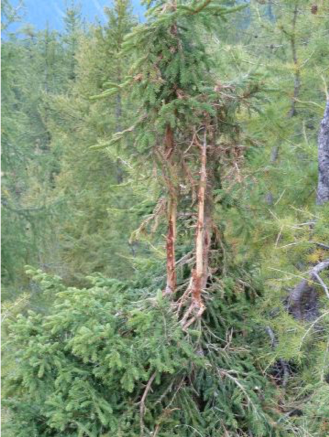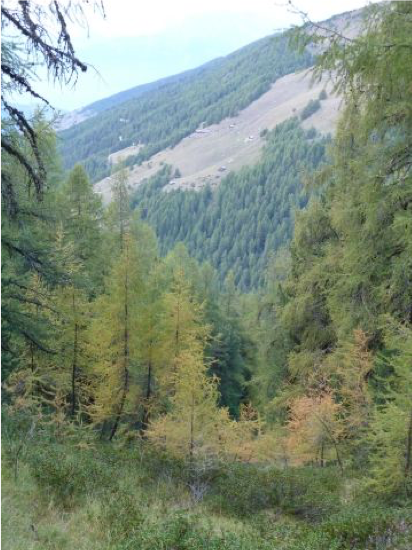RED DEER RUT - LE BRAME DU CERF
Sept 25th
Male Red Deer (by Bill Ebbesen Wikipedia)
Red Deer (Cervus elaphus) (cerf) are the fourth largest deer after moose, elk and the Asian sambhar. In Europe the stags are about 120cm at the shoulder and weigh up to 250kg. The stags start growing their antlers in spring and by autumn they are hard and bony, ready for the mating season or "rut". The gestation period for the hind (female) is about 8-9 months and mating takes place in the autumn so that the young are born at the start of summer when feeding is good and the weather mild. Red Deer are promiscuous, with one stag mating with up to 20 hinds. To attract hinds and keep off other males the stags make a roar sound, and strut around showing off their body size and antlers, and herding "their" hinds. When the hinds are ready to mate they can choose which stags they allow to mount them, and studies have shown that they find those which call loudest and most frequently, and which invest most time in herding them and fighting off other males are the most attractive. So there is a big incentive for the males to be pretty macho at this time of year.
Stag and hinds (by Deepsky, Wikipedia)
This whole process starts in mid-September and lasts only about 3 weeks. The males become loaded with testosterone, eat rather little, and spend their time wandering around looking for females to join their herd and picking a fight with anything that gets in their way or gives his girls the eye.
Although I have come across Red Deer fairly often in my wanderings I had never seen the rut and decided that 2011 had to be the year. This involved visiting the alps where they are most common and climbing to just below the tree-line (which is at about 2200m) where it all takes place. I found them at my first attempt on 19th Sept, but in a narrow steep valley where recent rain and snow had filled the river which drowned out the sounds. So my second sortie came a week later when I visited a larger more open valley.
The main rut activity comes at dusk and dawn so I set out late one afternoon, climbing steadily along a footpath. The trees were just entering their autumn colours and got more golden the higher I climbed. As I walked I passed plenty of signs of beaten up saplings where the stags had been practising or taking out their frustrations with their antlers. I rounded a corner and climbed along a shoulder, there were cows a still up in the alpine pastures whose bells tinkled away in the background, but I could hear a stag roaring in the forest on the opposite slope so I settled down to record pointing my parabola at the sound:
This was an impressively powerful sound in my headphones, I would guess he was about 200m line of sight from me across a small valley, and I was kind of happy he was not any closer! A Nutcracker (Nucifraga caryocatactes) was flying round calling raucously but when answered by the stag even it seemed to pause for thought. I think this was a lone stag, but I also heard what sounded like a struggle and maybe the clack of antlers which you can hear at 1m38s in this next piece, followed by what may have been a single call of victory, so maybe there were two competing:
It was by now falling dark so I needed to return to my car about an hours walk below me. As I descended a small flock of Nutcrackers were collecting nuts of the Arolla Pine for winter feed calling to each other in their whining manner:
Earlier on I had chatted with a farmer who had told me of another location where there was an active rut in an adjacent valley. So buoyed by my success I decided to spend the night in a small auberge and set off at 0430h the next day to find this other spot.
There was no moon to speak of and it was pitch dark when I arrived at the pasture (alpage), plus a slight mist had settled in this hollow, so there was nothing to be seen. The day before I had recorded calls from a single animal (above), so I was completely amazed at what I now heard (but could not see), there might have been up to 20 stags roaring in the dark. As dawn slowly came I could see their shadowy outlines amongst the cows who grazed away completely ignoring the mayhem around them. With advancing daylight most of the stags got less active and the herds slowly retreated in the surrounding forest. Here are three cuts taken from about an hours recording, you can hear them fading away as the birds start to call in the last cut:
I confess I had not wandered too far in the dark, they may be only 250kg but loaded with testosterone, armed with antlers and sounding like that, I decided it would not be smart to be mistaken for a competitor! However as the daylight came I could not help myself but follow one stag into the forest as he wandered around presumably looking for the girls. There were so many deer around that they had worn narrow trails as they wandered around and it was on one of those that he called ahead of me. I decided to stay well behind him and at one point a Black Woodpecker flew in between us which made for an interesting diversion:
I began to realise there were actually two stags up ahead, and that at least one had turned back and was now pretty close so my recording was distorted, but still could not see him due to the dense vegetation:
(Yes those were goats somewhere in the background)
I did not know what to expect if we came eyeball to eyeball (and was not sure I wanted to find out), and since the forest was pretty dense I sat down with my back to a large tree with a somewhat obscured view of a small clearing ahead of me. I heard the stag come back to the clearing, whilst another called some distance away, then there was a pause and he gave 4 very loud snorts whilst peering back at me, almost like a strong exhale of breath which resonated in his chest (and mine!) and echoed off the trees:
My guess was that either he had smelled me or maybe could see me, and that this was either an alarm call or a challenge, and apparently I stopped breathing. But thankfully he wandered off, and so did I - if it was a challenge I was not about to test it, but anyway he had a job to do and did not need me to become a distraction.
I returned to that region again about 4 weeks later at the end of October, by now autumn was in full swing with a smattering of snow already on the peaks and the trees were in great colours, and peace had once more returned to the valleys, the battles were over for another year.










